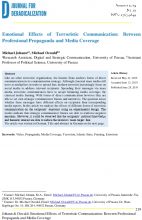Like no other terroristic organization, the Islamic State anchors forms of direct communication in its communication strategy. Although classical mass media still serve as multipliers in order to spread fear, modern terrorists increasingly focus on social media to address relevant recipients. Spreading their messages via mass media, terroristic communicators have to accept balancing media coverage: the classical media framing. With forms of direct communication however they are able to set own strategic communicator frames and narratives. The question arises whether these messages have different effects on recipients than corresponding media reports. In this article we analyze the effects of different forms of terroristic communication on the recipients’ emotions using an experimental design. The results indicate that strategic communicator frames are able to reinforce negative emotions. However, it could be observed that the recipients’ political knowledge and thematic interest are able to reduce the terrorists’ main target: fear.
